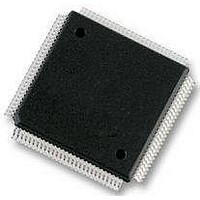MC912D60CCPVE Freescale Semiconductor, MC912D60CCPVE Datasheet - Page 439

MC912D60CCPVE
Manufacturer Part Number
MC912D60CCPVE
Description
IC MCU 16BIT 112-LQFP
Manufacturer
Freescale Semiconductor
Series
HC12r
Datasheet
1.MC912D60ACFUE8.pdf
(460 pages)
Specifications of MC912D60CCPVE
Core Processor
CPU12
Core Size
16-Bit
Speed
8MHz
Connectivity
CAN, MI Bus, SCI, SPI
Peripherals
POR, PWM, WDT
Number Of I /o
68
Program Memory Size
60KB (60K x 8)
Program Memory Type
FLASH
Eeprom Size
1K x 8
Ram Size
2K x 8
Voltage - Supply (vcc/vdd)
4.5 V ~ 5.5 V
Data Converters
A/D 16x8/10b
Oscillator Type
Internal
Operating Temperature
-40°C ~ 85°C
Package / Case
112-LQFP
Processor Series
HC912D
Core
HC12
Data Bus Width
16 bit
Data Ram Size
2 KB
Interface Type
CAN, SCI, SPI
Maximum Clock Frequency
8 MHz
Number Of Programmable I/os
86
Maximum Operating Temperature
+ 85 C
Mounting Style
SMD/SMT
3rd Party Development Tools
EWHCS12
Minimum Operating Temperature
- 40 C
On-chip Adc
10 bit, 8 Channel
Lead Free Status / RoHS Status
Lead free / RoHS Compliant
Available stocks
Company
Part Number
Manufacturer
Quantity
Price
Company:
Part Number:
MC912D60CCPVE
Manufacturer:
FREESCAL
Quantity:
203
Company:
Part Number:
MC912D60CCPVE
Manufacturer:
Freescale Semiconductor
Quantity:
10 000
- Current page: 439 of 460
- Download datasheet (5Mb)
22.2.2.3 EEPROM AUTO programming & erasing
22.2.2.4 EEPROM Selective Write More Zeros
22.2.3 STOP mode
MC68HC912D60A — Rev. 3.1
Freescale Semiconductor
to be set by programming an 10-bit time base pre-scalar into bits spread
over two new registers, EEDIVH and EEDIVL.
The EEDIVH and EEDIVL registers are volatile. However, they are
loaded upon reset by the contents of the non-volatile SHADOW word
much in the same way as the EEPROM module control register
(EEMCR) bits interact with the SHADOW word for configuration control
on the existing revision.
The second major change to the EEPROM is the inclusion in the
EEPROM control register (EEPROG) of an AUTO function using the
previously unused bit 5 of this register.
The AUTO function enables the logic of the MCU to automatically use
the optimum programming or erasing time for the EEPROM. If using
AUTO, the user does not need to wait for the normal minimum specified
programming or erasing time. After setting the EEPGM bit as normal the
user just has to poll that bit again, waiting for the MCU to clear it
indicating that programming or erasing is complete.
For some applications it may be advantageous to track more than 10k
events with a single byte of EEPROM by programming one bit at a time.
For that purpose, a special selective bit programming technique is
available.
When this technique is utilized, a program / erase cycle is defined as
multiple writes (up to eight) to a unique location followed by a single
erase sequence.
This new version will correctly exit STOP mode without having to
synchronize the start of STOP with the RTI clock.
Appendix: Changes from MC68HC912D60
Significant changes from the MC68HC912D60 (non-suffix device)
Appendix: Changes from MC68HC912D60
Technical Data
439
Related parts for MC912D60CCPVE
Image
Part Number
Description
Manufacturer
Datasheet
Request
R
Part Number:
Description:
Manufacturer:
Freescale Semiconductor, Inc
Datasheet:
Part Number:
Description:
Manufacturer:
Freescale Semiconductor, Inc
Datasheet:
Part Number:
Description:
Manufacturer:
Freescale Semiconductor, Inc
Datasheet:
Part Number:
Description:
Manufacturer:
Freescale Semiconductor, Inc
Datasheet:
Part Number:
Description:
Manufacturer:
Freescale Semiconductor, Inc
Datasheet:
Part Number:
Description:
Manufacturer:
Freescale Semiconductor, Inc
Datasheet:
Part Number:
Description:
Manufacturer:
Freescale Semiconductor, Inc
Datasheet:
Part Number:
Description:
Manufacturer:
Freescale Semiconductor, Inc
Datasheet:
Part Number:
Description:
Manufacturer:
Freescale Semiconductor, Inc
Datasheet:
Part Number:
Description:
Manufacturer:
Freescale Semiconductor, Inc
Datasheet:
Part Number:
Description:
Manufacturer:
Freescale Semiconductor, Inc
Datasheet:
Part Number:
Description:
Manufacturer:
Freescale Semiconductor, Inc
Datasheet:
Part Number:
Description:
Manufacturer:
Freescale Semiconductor, Inc
Datasheet:
Part Number:
Description:
Manufacturer:
Freescale Semiconductor, Inc
Datasheet:
Part Number:
Description:
Manufacturer:
Freescale Semiconductor, Inc
Datasheet:











